

The disadvantage, however, is that it is organic, and subject to decay. Since it is less permanent than many other materials, we have few surviving examples of ancient wooden artifacts.
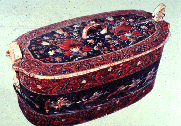 A
variety of simple techniques are used to embellish and shape wood. First, wood
can be painted. Painting has a double purpose; first, preservation.
Paint seals the surface and prevents decay of the wood. Second, embellishment--
paint adds color and decoration.
A
variety of simple techniques are used to embellish and shape wood. First, wood
can be painted. Painting has a double purpose; first, preservation.
Paint seals the surface and prevents decay of the wood. Second, embellishment--
paint adds color and decoration.
 Wood
can also be carved. Only the simplest of tools-- at a minimum,
a knife-- is necessary to carve wood. Therefore we can have the simple, relatively
unskilled carvings of folk artists, such as Norwegian chip carving, used to
embellish boxes and tools, or a carved altar frontal made by an immigrant farmer
for his frontier church. On the other hand, we also have the sophisticated work
of master craftsmen, as can be seen in examples of Victorian furniture, or medieval
gothic church interiors.
Wood
can also be carved. Only the simplest of tools-- at a minimum,
a knife-- is necessary to carve wood. Therefore we can have the simple, relatively
unskilled carvings of folk artists, such as Norwegian chip carving, used to
embellish boxes and tools, or a carved altar frontal made by an immigrant farmer
for his frontier church. On the other hand, we also have the sophisticated work
of master craftsmen, as can be seen in examples of Victorian furniture, or medieval
gothic church interiors.
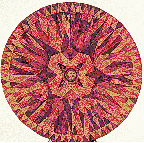 Marquetry
is a method of cutting thin sheets of different colored woods (veneers)
and cutting shapes from them to inlay a design on a wooden surface, such as
a table, cabinet, or box. This technique is widely found on luxury furnishings,
from China, to Europe, and the Middle East.
Marquetry
is a method of cutting thin sheets of different colored woods (veneers)
and cutting shapes from them to inlay a design on a wooden surface, such as
a table, cabinet, or box. This technique is widely found on luxury furnishings,
from China, to Europe, and the Middle East.
 Turning
involves the use of a lathe, introduced in Europe in the 16th century.
The piece of wood is spun while being held in the lathe, and a knife or shaped
cutting tool is held against it as it turns, resulting in symmetrically curved
forms. Typical turned products are elaborate spindles used in stair railings,
or the rounded spindle and legs of furniture such as a Windsor chair, and wooden
bowls. This link will take you to a Web gallery maintained by a
Woodturners
group .
Turning
involves the use of a lathe, introduced in Europe in the 16th century.
The piece of wood is spun while being held in the lathe, and a knife or shaped
cutting tool is held against it as it turns, resulting in symmetrically curved
forms. Typical turned products are elaborate spindles used in stair railings,
or the rounded spindle and legs of furniture such as a Windsor chair, and wooden
bowls. This link will take you to a Web gallery maintained by a
Woodturners
group .
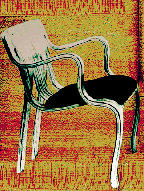 A
peculiar characteristic of wood is that it can be bent if it
is soaked in water. Other solutions, such as glycerine may be used to enhance
this flexibility. This technique has long been used in the making of functional
items such as round boxes (like those made by the Shakers), and in making wooden
baskets from slats of softened wood. In the late 19th century,the French designer
Thonet produced a series of bentwood chair designs that have become classics,
and are still in production.
A
peculiar characteristic of wood is that it can be bent if it
is soaked in water. Other solutions, such as glycerine may be used to enhance
this flexibility. This technique has long been used in the making of functional
items such as round boxes (like those made by the Shakers), and in making wooden
baskets from slats of softened wood. In the late 19th century,the French designer
Thonet produced a series of bentwood chair designs that have become classics,
and are still in production.
Wood has always been used for the making of furniture. This includes storage
units, such as trunks and cabinets, but also the making of other furniture,
such as chairs. The earliest examples of chairs have been found in Egyptian
tombs dating to about 1500-1350 BC. The Chinese also used chairs, and in the
18th c. Chinese chairs inspired the great furniture maker, Chippendale, in his
design of chairs that have become classics in European design. Today there are
still craftsmen/designers working in wood to create beautiful furniture,
relying on the ancient methods and skills of the woodworker to create modern
designs.
 Wood
has also been used for the creation of shelter since prehistoric times. The
bark and sapling structures as made by East Coast Indians and
copied by early settlers in 17th c. New England have been reproduced at Plimouth
Plantation in Massachusetts.
Wood
has also been used for the creation of shelter since prehistoric times. The
bark and sapling structures as made by East Coast Indians and
copied by early settlers in 17th c. New England have been reproduced at Plimouth
Plantation in Massachusetts.
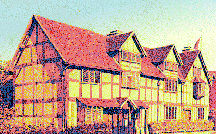 Another
common form of traditional house construction is the half timbered
house. It is commonly associated with Tudor England of the 16th century, but
was brought to the Americas by English settlers in the 17th century. The skeleton
of the house is made of heavy timbers, with stone and plaster used to fill the
large spaces between the timbers. This method is often used where wood is in
limited supply. On occasion, this structure may be later covered with wood siding,
as it often was in 18th century America.
Another
common form of traditional house construction is the half timbered
house. It is commonly associated with Tudor England of the 16th century, but
was brought to the Americas by English settlers in the 17th century. The skeleton
of the house is made of heavy timbers, with stone and plaster used to fill the
large spaces between the timbers. This method is often used where wood is in
limited supply. On occasion, this structure may be later covered with wood siding,
as it often was in 18th century America.
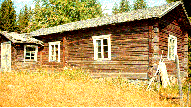 Just
as half timbered construction methods were brought to this country by early
English immigrants, so also were various styles of log construction. For example,
the square cut log houses still found in Northern Minnesota, built by Finnish
immigrants,closely resemble the log houses seen in Finland. Log construction
was common on the American frontier because of the abundance of free wood, and
the lack of equipment to readily turn logs into boards.
Just
as half timbered construction methods were brought to this country by early
English immigrants, so also were various styles of log construction. For example,
the square cut log houses still found in Northern Minnesota, built by Finnish
immigrants,closely resemble the log houses seen in Finland. Log construction
was common on the American frontier because of the abundance of free wood, and
the lack of equipment to readily turn logs into boards.
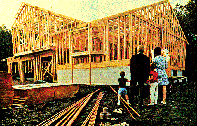 In
time, as wood became less available, and mills provided standardized lumber,
the lighter frame construction became the standard method of home construction
in this country. Typically a skeleton of 2" x 4" lumber is covered with boards,
insulation, and siding, with a plaster surface on the inside.
In
time, as wood became less available, and mills provided standardized lumber,
the lighter frame construction became the standard method of home construction
in this country. Typically a skeleton of 2" x 4" lumber is covered with boards,
insulation, and siding, with a plaster surface on the inside.

|